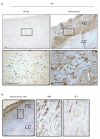Mesenchymal stem cells-derived vascular smooth muscle cells release abundant levels of osteoprotegerin
- PMID: 30256862
- PMCID: PMC3167277
- DOI: 10.4081/ejh.2009.e3
Mesenchymal stem cells-derived vascular smooth muscle cells release abundant levels of osteoprotegerin
Abstract
Although several studies have shown that the serum levels of osteoprotegerin (OPG) are significantly elevated in patients affected with atherosclerotic lesions in coronary and peripheral arteries, the cellular source and the role of OPG in the physiopathology of atherosclerosis are not completely defined. Therefore, we aimed to investigate the potential contribution of mesenchymal stem cells in the production/release of OPG. OPG was detectable by immunohistochemistry in aortic and coronary atherosclerotic plaques, within or in proximity of intimal vascular smooth muscle cells (SMC). In addition, bone marrow mesenchymal stem cell (MSC)-derived vascular SMC as well as primary aortic SMC released in the culture supernatant significantly higher levels of OPG with respect to MSC-derived endothelial cells (EC) or primary aortic EC. On the other hand, in vitro exposure to full-length human recombinant OPG significantly increased the proliferation rate of aortic SMC cultures, as monitored by bromodeoxyuridine incorporation. Taken together, these data suggest that OPG acts as an autocrine/paracrine growth factor for vascular SMC, which might contribute to the progression of atherosclerotic lesions.
Keywords: atherosclerosis.; mesenchymal stem cells; osteoprotegerin; smooth muscle cells.
Figures


References
-
- Abedin M, Omland T, Ueland T, Khera A, Aukrust P, Murphy SA, et al. Relation of osteoprotegerin to coronary calcium and aortic plaque. Am J Cardiol. 2007;99:513–8. - PubMed
-
- Avignon A, Sultan A, Piot C, Mariano-Goulart D, Thuan Dit Dieudonné JF, Cristol JP, et al. Osteoprotegerin: a novel independent marker for silent myocardial ischemia in asymptomatic diabetic patients. Diabetes Care. 2007;30:2934–9. - PubMed
-
- Beltrami AP, Cesselli D, Bergamin N, Marcon P, Rigo S, Puppato E, et al. Multipotent cells can be generated in vitro from several adult human organs (heart, liver, and bone marrow) Blood. 2007;110:3438–46. - PubMed
-
- Fu M, Zhang J, Lin Yg Y, Zhu X, Wilsson TM, Chen YE. Activation of peroxisome proliferator-activated receptor γ Inhibits osteoprotegerin gene expression in human aortic smooth muscle cells. Biochem Biophys Res Commu. 2002;294:597–601. - PubMed
Publication types
LinkOut - more resources
Full Text Sources

